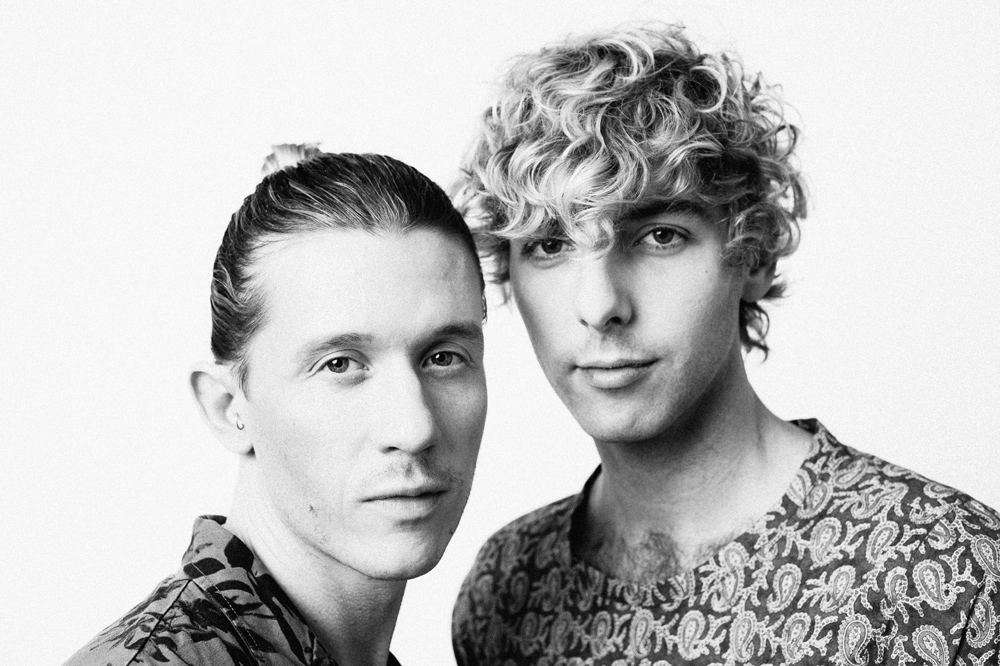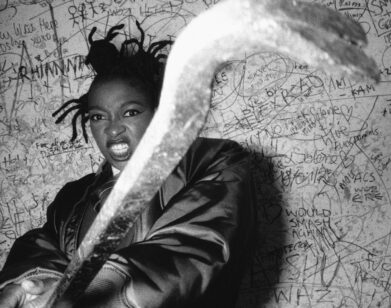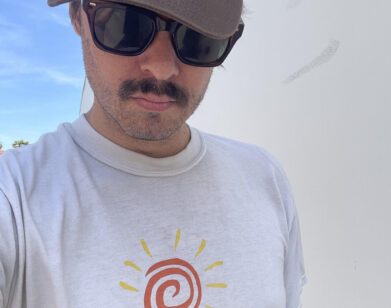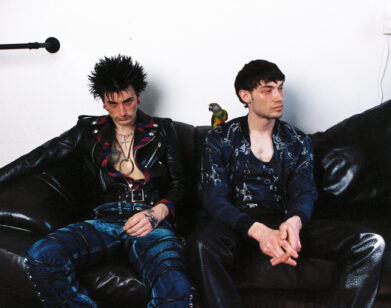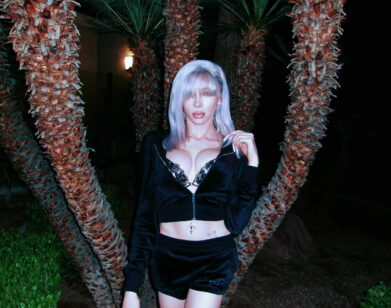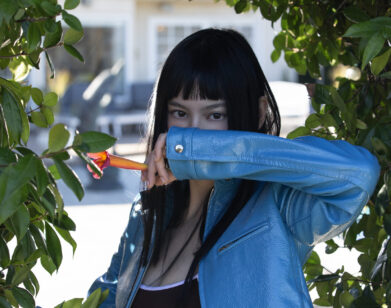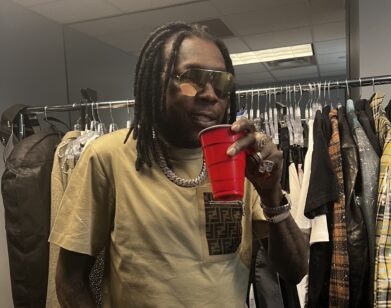Exclusive Video Premiere: ‘Roller Coaster,’ Baby Alpaca
ABOVE: BABY ALPACA (CHRIS KITTRELL AND ZACH MCMILLAN) IN LOS ANGELES, DECEMBER 2014. PHOTOGRAPHY BY CARA ROBBINS. STYLING: GENA TUSO. GROOMING: MEL DANIEL/THE WALL GROUP.
Brooklyn-based band Baby Alpaca has demonstrated a talent for matching stunning visuals with expressive, ambient music throughout their entire body of work. Psychedelic and surreal, every music video adds a second level of creativity that boosts their credit for well-rounded, artistic aptitude. In their latest video for the track “Roller Coaster,” frontman Chris Kittrell (vocals/autoharp) stepped aside and only acted instead of taking part in all aspects of the creative process, inlcuding the conceptualization, filming, and production, which were done by Zach McMillan (guitar/piano) and creative partner Aaron Maurer.
While shooting at McMillan’s mother’s farm on Whidbey Island, located northwest of Seattle and forming the northern boundary of Puget Sound, the guys had a limited cast and crew, relying on friends from San Francisco and New York—as well as McMillan’s mother’s neighbors—to pitch in. The result? An evocative portrait of connectivity opposed to isolation, reality versus imagination.
Kittrell stars as the main character of the video, finding himself amidst a group of compelling strangers. Full of mysterious cocktails, frenzied group sex scenes, and consistent nods to old horror films, the video is oddly appropriate for the steamy song. “Roller Coaster,” the first single released since Baby Alpaca’s 2013 debut EP and 2014 compilation of remixes (Strictly Sexual (Remixes)), keeps in line with the band’s reputation for blending sounds reminiscent of ’80s pop and modern folk through electronic abstraction.
We spoke with Kittrell and McMillan over the phone about the video for “Roller Coaster,” which is premiering here on Interview.
MATHIAS ROSENZWEIG: In the beginning of the video, we see the main character accompany a stranger to her house, filled with other strangers. Why did you immediately put him in this alien environment?
ZACH MCMILLAN: Aaron and I had been thinking a lot about making a narrative music video, something that was like a short film condensed into a music video rather than a conventional music video of somebody singing. Our huge influences for this were early Roman Polanski, like The Tenant, Rosemary’s Baby, Repulsion, [and] also early ’70s Nicholas Roeg, like Don’t Look Now, and Donald Sutherland. All these films, they’re psychological thrillers, they have these visual motifs, and they take a character and place that character into a new environment that either drives the character crazy or it’s about self-discovery…we were really playing on those conventions and this is a set up. We wanted to create a world where it’s like, “Is it real? Is it not? Is it inside its head? Is it not? What’s going on?” It’s paranoia; it’s sexual; it’s reliving things; it’s getting away from linearity.
ROSENZWEIG: The characters in the video seem to span all ages, genders, and sexualities. What was the purpose of having such a diverse group?
MCMILLAN: Aaron and I were thinking about how to make things more open and less defined. If it were just guys [or] if it were just girls with Chris, it seemed to miss the point. We were interested just in sexuality and I think especially right now, even worrying about those boundaries or those lines is something that we didn’t want to engage. I didn’t want to make the sex scenes about heterosexuality or homosexuality. I wanted it to be about sexuality, and sexy, and really not distinguishing what that means in terms of gender or biological sex. So the natural thing to us was to just throw everybody in there. Everybody’s interested; it’s the energy from this whole crew–everybody’s in on it and trying to seduce this outside character.
CHRIS KITTRELL: It’s like when I have the dose of that drink in the beginning of the video, I become kind of a shell of a person in a way. I’m in the palms of the hands of these new people that I’ve met and am open to any kind of journey they’re wanting me to go on, almost like someone was completely un-socialized in the world and then they were put into this romantic, dark, erotic situation.
ROSENZWEIG: The video shows somewhat carnal and polygamous sexual behavior. Were you avoiding monogamy and going for something more unconventional?
MCMILLAN: Yes, we were going for a group thing, specifically, again, because of these influences. Like in the early Polanski and Roeg stuff, there’s one character and then a group of people. Like in The Tenant, Roman Polanski plays this character called Trelkovsky, he rents an apartment in Paris, and then he becomes paranoid that the other tenants and his neighbors are trying to turn him into the past tenant, who committed suicide. So it’s sort of a group against an individual.
In Rosemary’s Baby, it’s a cult, and in our video, it’s this sort of working farm cult or however you want to interpret it. But everybody knows something that Chris doesn’t know about. I think the line between the individuals becomes a little bit blurred for the cult members. Something’s going on and it’s more dreamlike. When you have a sex scene or really intimate scene with let’s say, Chris and one other person, then that other person becomes a very specific character with their own narrative. I wanted this to really stay focused on Chris and whether it’s in his head or not in his head, I wanted the questions to all be able to be understood through the lens of one character, Chris.
ROSENZWEIG: In all honesty, the video gave me major Martha Marcy May Marlene vibes.
MCMILLAN: I really love that film. I think that when we started thinking about cults, you think about these group sex scenes–it’s not so much about an individual or a psychopath or these different horror tropes. It’s about this group and seduction and something more surreal that’s happening. And like Chris said, after he drinks that first glass of whatever it is, he’s kind of cast in this spell. He’s under the influence of this group.
ROSENZWEIG: How do you think the song, in terms of lyrics and mood, fit in with the video and its narrative?
KITTRELL: I don’t think that they were too literally tied into each other. In the song, it’s kind of about letting yourself fall in love as a ride, not taking yourself too seriously, and just being game, not thinking about what’s going to happen. It’s like being childlike, but in a sense where you’re having fun, you go for it without any worries, and maybe even forget about bad burns that you’ve had before. It’s a little bit ornery, a little bit funny, a little bit sweet.
MCMILLAN: When storyboarding and thinking about what we could do for a narrative to this song, the song is just really sexy, so we wanted that element, and we wanted to tell a story. We thought that creating a narrative music video that was more like a film than something that was literally related to the lyrics could provide juxtaposition. I think the juxtaposition of the song with the video produces something totally new that neither of them can do alone. In that way, it’s a different act of creation. So you listen to the song, and you wouldn’t necessarily think of this video, but when you watch the video and hear the song together, there’s something intuitive that makes sense. It’s not jarring. It’s not like, “This doesn’t work at all. Why aren’t they on a roller coaster?” But it creates something new.
KITTRELL: I actually did have somebody ask me why the video wasn’t on a roller coaster.
ROSENZWEIG: What do you want the audience to feel toward the end of the video, when the pace and content becomes a bit more manic?
MCMILLAN: We were trying to build a climax, making an arc that built to this moment when he discovered what’s really going on, which is not totally clear in this video. I think that it sets up some questions, but also with the throat slitting, doing these flash images relied more on visual motifs and connections and it was more impressionistic and set up even more questions. So we wanted an ending style that was much more reminiscent of the Nicholas Roeg theme, where these different experiences and impressions that he had, these abstract symbols, create the meaning, rather than just the literal act of having his throat slit, which on its own, to me, is really not that engaging or interesting. The idea that there’s imagery happening and it’s not meant to be taken violently or literally, even though it is a violent image in this horror genre, was the goal. [Another goal] was to really to do it as a set up and nod to the next video, which is going to be using a lot of surreal, impressionistic imagery.
ROSENZWEIG: What issues did you run into while filming?
MCMILLAN: It was so much about preparation because with the group of actors that we had, it was a four-day shoot. But then we had a week for pick-up shots. With the crew being essentially Aaron and me, doing all the lighting, all the directing, all the filming, it had to be shot-by-shot planned, so we planned for about two weeks, storyboarding everything down to the angle. Of course some things happened spontaneously and you need to be flexible, but really it was having a very specific vision that we articulated beforehand. We had organized exactly what costumes were needed on what days because we couldn’t shoot in chronological order, down to, “I guess we better get a lot of whiskey,” because we didn’t plan on it being 20 degrees outside, and they needed to be naked in the woods for five hours.
KITTRELL: I think a handle of whiskey in the woods always leads to happy accidents.
MCMILLAN: There’s inevitably chaos on a shoot and you need to just roll with it, be really flexible, and try to have a lot of fun and get people feeling comfortable. I think that comes through on the video. I mean, nobody’s a professional actor, you know?
KITTRELL: I did study at Strasberg…
ROSENZWEIG: So there was one professional actor?
KITTRELL: I was more just joking. [laughs] It was definitely not a Strasberg-type acting technique. It’s really in the moment, kind of candid. Just feeling like you are there. We’re all so close and comfortable with each other as friends, which is also probably the best fruit to bear of making art with friends. We were just in the woods living with each other. It was playful and us having a good time. We do all really love each other so much and so all the scenes came really naturally.
There are scenes, actually, that I don’t even remember being in because of the nature of the shoot. It was freezing outside, we were drinking a lot sometimes, and it would get late and Aaron and Zach are pushing us to shoot more and probably using me almost like a half-there actor. The best one that I don’t remember is [when] I’m lying down and getting kissed on the mouth and my face is getting kind of painted. [I’m] just lying there, sort of serene looking. I was completely unaware of what was going on, like absolutely blacked out.
MCMILLAN: There’s footage that should never be shown to the public.
BABY ALPACA IS CURRENTLY RECORDING THEIR DEBUT FULL-LENGTH ALBUM IN L.A. YOU CAN DOWNLOAD “ROLLER COASTER” FOR FREE VIA THE BAND’S SOUNDCLOUD.

